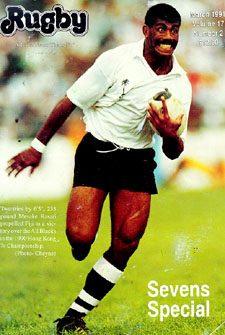 |
|
|---|---|
| Home- About Rugby7.com- Database- Tournaments | |

Sevens around the World
Until recently, one would have had a hard time figuring out where to go for expert advice on the playing of sevens.
Melrose and Middlesex were well established, and presumably one would consult with regular winners at these tournaments.
Nevertheless, it was hard to know whether their techniques were any better than those employed by other sevens' teams from other parts of the globe, few and far between as they were, and as little as they interacted.
The Hong Kong Sevens have changed all that. The years 1976- 1990 have been marked by the expansion, not only of the game of sevens, but also of ideas about the game and how to play it.
Certainly one wishing to explore elements of the game of sevens by interviewing the experts would still want to go to the Scottish Borders, sevens' cradle, and to Middlesex, where sevens began to mature.
But it is also clear, 15 years after Hong Kong revolutionized sevens, that one cannot claim to have spoken to the experts of sevens rugby without having included the Fijians, the Australians, and the New Zealanders.
Among them, these three nations (or, in the early years their representatives) have won all but one of the 15 Hong Kong Sevens. In addition, their presence is being felt at the club level, as well: in the 100th playing of the Melrose Sevens (1990), Australia's Randwick topped a field that included all the top Scottish teams as well as the perennial Middlesex champion Harlequins. Even Randwick, however, and its New Zealand counterpart clubs such as Auckland Marist, perennially get thumped in club sevens tournaments in Fiji.
Smaller nations that have not made any impact on the fifteens scene also have left their mark on the sevens' world: the Hong Kong team itself, for example, made it to the Cup round in 1989 and won the Plate in 1990. Recently,
the US has defeated Wales (1989) and Argentina (1988,1990), feats it has never achieved in fifteens.
Thus the chapters that follow will represent views from around the world; my sources will be discussed below.
Styles of Play
Despite all the innovations that have take place in the game of sevens during the last 15/20 years, the basics styles of play remain pretty much those described by Mike Williams in his 1975 book: the "bodily contact style," the "possession style," an "all-action style," and styles that combine elements of these three basic styles.
Of the first, Williams writes:
The bodily contact style . . . depends on winning possession and then using that possession to test out your opposite number at every opportunity to find out his weaknesses. It is a style committed to physical contact and aggression. It produces very direct rugby with plenty of tackling and mauling and is more akin to rugby league than it is to the style of sevens known at Twickenham. . . . This style must be seen as the original sevens style
.
This style remains, as it probably has since 1883, the preferred style of play in the Scottish Borders. It has also received new-found respect in recent years, having been adopted and espoused by the All-Blacks in the mid-1980s.
The London Scottish of the 1960s were considered the pioneers of the "possession style," and Williams quotes their leader, Iain Laughland:
"The first [rule] is that you must get the ball. . . . The second rule is that when one of your side is in possession there must be another player within five yards of him. That's irrespective of the tactical situation or the position on the field."
The "possession style" in its purest sense often results in slow paced games in which the team in possession refuses to challenge the opponents until its passing patterns have caused a defensive mistake. Only at that point -- and if they're virtually assured that they will be able to penetrate or overlap the defense, will they attack. Other descriptions of this style: "keep-away" and "cat and mouse."
The possession style continues to be what people think about when they think of sevens: a "keep-away" game in which going backwards is no sin. This style remains the favorite of most London teams, as well as 5-time Hong Kong champion Australia.
The "all-action style," which Williams associates with the Loughborough Colleges teams of the 1960s, involves
a storming all-action game, with the ball being won, retained and run at the opposition all through. The players rely on their superior fitness to beat their opponents.
At the international level today perhaps the national teams of Samoa and Tonga -- and to a lesser extent, Fiji, who has mastered some of the elements of the possession style -- best exemplify this "throw care to the wind" style of play.
In fact, because of the abandonment of the "keep-away" mentality, the "all-action" game turns very easily into a bodily contact style. Thus Chris Bass in his 1981 book preferred to characterize sevens into two, rather than three basic styles:
The fast, aggressive, direct, "cut and thrust" approach (bodily contact and all-action) . . . and the "cat and mouse" style.
If we think in American basketball terms, we can liken the first to wide-open Loyola/Marymount, or even UNLV, basketball, and the second to the controlled Princeton style.
In the end, although we can define and refine the way we describe these styles, we are really talking about tendencies; in fact, virtually all teams utilize a combination of the styles described above, with more or less weight being given to each component depending on the team's overall tendencies.
Australia's John Maxwell is among those that feels that it's unwise to be wedded to any one style:
I don't think you can play a textbook way; that's why you've got to have players that can adapt to what's going on, what they should do.
That's one of the great pluses of our club [Randwick]; we can vary our game in terms of the team we're playing.
National Tendencies
The following is a brief synopsis of the predominant tendencies of teams from some of the major sevens regions of the world, in both the Northern and Southern hemisphere.
- Scotland
- England
- New Zealand
- Australia
- Fiji
In the Scottish Borders, where the game began, the style of sevens tends to mirror the traditionalism associated with Scottish rugby in general. Border sides play with little finesse: they come right at their opponents and initiate the confrontation.
During the past dozen years the top Borders sevens team has certainly been Kelso. Their coach, Jim Hewitt, notes that If you watch the London teams playing, you'll see that if there isn't a 60/40 chance of breaking, they'll wait until they get that. We'll take a 40% chance and try to break through. And all the Border sides are the same. It's just the way we play.
Melrose coach (and former Scotland and British Lions coach) Jim Telfer adds:
We tend not to have flyers on our teams. Just because of the place we come from, we don't produce men who can individually beat a man. So our players work a lot harder, probably, off the ball, than do the teams down south [London], who tend to have flyers on the wing who rest for periods while the other six work and then they give him the ball. We're more an all-action type of sevens; we tend to be more aggressive, more physical in the way we play sevens.
Scottish teams tend to focus on the physical side of the game in the scrums as well as the open field, and contest possession at the set pieces probably harder than any one else in the world.
As Scottish sevens is synonymous with Scottish Borders' sevens, so English sevens is synonymous with London sevens: and of the London sevens teams, none is more proficient at the game than the Harlequins, Middlesex winners in 1986, 1987, 1988, 1989, and 1990.
Harlequins' coach Dick Best says of his team's style,
I believe that we should attack from everywhere and anywhere, and just basically keep the game fluid. It's so important that when you win the ball you keep hold of it -- you get depth of support, players working off the ball, letting the ball do the work -- all the while avoiding contact at all costs.
So pervasive had the London style of sevens become, and so "forgotten" the continuing body contact game of the Scots, that when New Zealand developed their powerhouse approach to sevens, they thought they had invented a new game.
Bryce Rope was the coach of the All-Blacks during their development as a sevens power in the 1980s:
I said to our team in 1986, we will change our pattern, we will never go backwards on attack or defense, and we formed a special pattern to put this new aggressive approach into being. It destroyed the game of seven-a-side rugby as it had been played for over 100 years.
Revolutionary outside of Scotland perhaps, but what was really new about the All-Blacks' style was how well they executed it. As Jim Telfer noted,
perhaps the team that plays the closest style to that in the Borders is the All-Blacks . . . and they probably do it better.
New Zealand's approach to defense is just as aggressive as its approach to attack: whereas most sevens teams defend with six players at the front line and one sweeper covering deep, New Zealand's predominant tendency is to challenge the defenders with seven players up front, relying on a player away from the ball to cover kicks.
Of a totally different attacking view from Rope and Freeman is Australian coach Bob Dwyer, who claims that sevens
is not a game for putting opposition defenses under direct pressure; it's a game for outmaneuvering opposition defenses. . . I would love to play the game where none of my players were tackled in possession.
Certainly the most exciting, and often the best, sevens nation in the world, Fiji supplements a team with world-class speed with ball-handling and support skills second to none.
Certainly the natural athleticism of a seemingly high percentage of Fijians helps: "You can see the natural build of a Fijian," notes coach Kitione Tuibua, "it is suited to a good seven-a-side player."
Fiji combines an all-action style of play with elements of the possession game: it is always looking to run through gaps in the opposition, but if they close up, rather than barrelling into the opponent as the Samoans and Tongans sometimes do, the Fijians have an uncanny knack of firing the ball back to support players lying in exactly the right places. Fiji minimizes the role of contact; per Tuibua, as soon as the player commits himself to the defender, the body is there but the ball has gone.
Defensively, Fijians are among the hardest tacklers in the world, and not many ball carriers are able to stay on their feet when smothered by a hard Fijian tackle. At the 1990 Hong Kong Sevens, Fiji played a gambling, blitzing defense that completely took the All-Blacks out of their game,
Elements of the Game
When people speak of styles and tendencies, they normally refer to how teams deal with possession, and that is what has been discussed above. The game, of course is composed of many elements, defensive as well as attacking, and of course, situations where possession itself is the issue.
The chapters that follow will deal with the game from the perspective of the following situations:
- Attack in the Open Field
- Defense in the Open Field
- Kickoffs and Drop Outs
- Set Scrums
- Lineouts
- Set Ploys from Possession
- Kicking